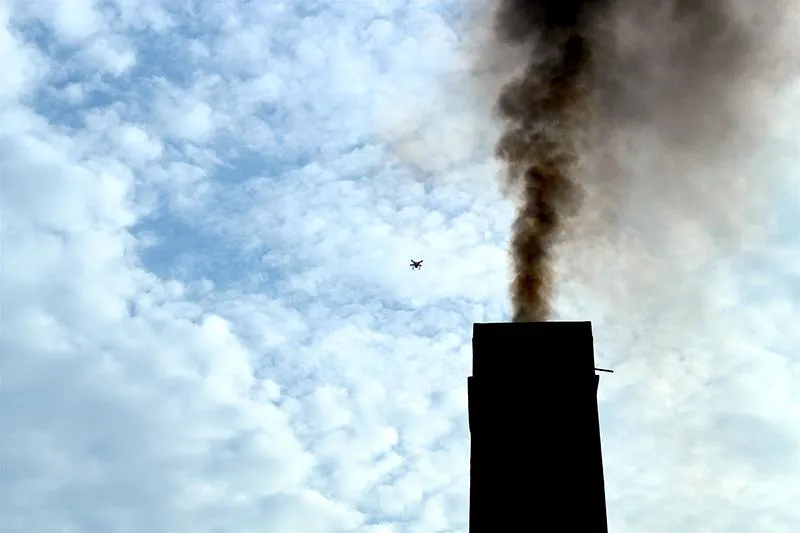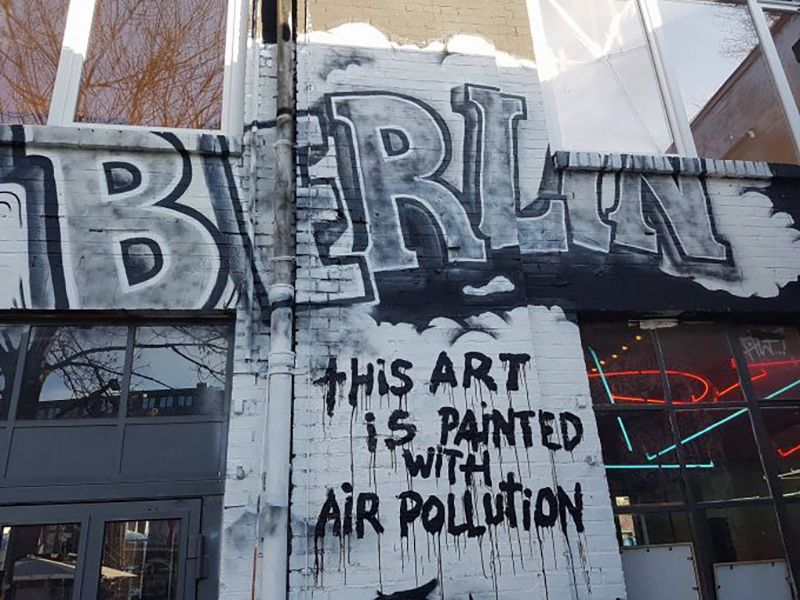This Ink Is Made From Air Pollution
About 45 minutes of diesel car pollution reaps 30 milliliters of AIR-INK, now on display at the Cooper Hewitt, Smithsonian Design Museum
/https://tf-cmsv2-smithsonianmag-media.s3.amazonaws.com/filer/c3/8b/c38bb00d-362c-4999-ba37-eb143774b573/airink_product_shots4.jpg)
On a trip to India in 2012, Anirudh Sharma captured a photo of a diesel generator blowing black soot against a white wall. That dark, triangular stain made Sharma, who was then a student at Massachusetts Institute of Technology’s Media Lab, think seriously about pollution—and also about pigments, like ink.
The black ink we use in our pens or in inkjet printers is essentially made from soot. The technical term for the substance is “carbon black,” and it is the powder that remains after burning coal or oil. The powder is mixed with a polymer and a solvent to turn it into smooth, flowing black rollerball ink.
“So, if you can do it with soot, can we do the same with air pollution?” Sharma explains. “The black color in the pen you use is made by burning fossil fuels to make ink. But you shouldn’t need to burn new fossil fuels just to make ink. Fossil fuels are already being burned.”
If he could find a way, he thought, to capture the particles that produced that stain on the wall in his photograph, he could not only reduce the amount of pollution released into the air, but also turn it into something new, or perhaps something beautiful.
“Ink is such a powerful medium to connect with people. A book has black ink. In art, you use black ink. Fashion and textiles use black ink,” says Sharma. He reflects on a quote from 20th century inventor and architect R. Buckminster Fuller: "Pollution is nothing but resources we're not harvesting. We allow them to disperse because we've been ignorant of their value."
In 2013, Sharma and a few friends “hacked” an inkjet printer cartridge to print using ink made from soot from a candle at the Fluid Interfaces Group at MIT’s Media Lab. A year later, following the completion of his master's degree at MIT, Sharma returned to India to focus fully on developing what would become a product called AIR-INK, the first commercial ink made entirely from air pollution. It started as a small proof of concept experiment using soot from air pollution to make paint. When it worked, he and his team built a lab in a small garage in Bangalore to create a device that could capture air pollution at the source, in engines or factory machinery. In the six months they spent in India refining their technology, it wasn’t hard to find pollution sources for experimenting.
Sharma explains that in Western countries, like the United States, stricter regulations already require companies to dispose of carbon particulates responsibly. However, in places like India where regulations are more relaxed, waste builds up quickly at small to medium-size businesses because it can be expensive to dispose. Without systems in place to get rid of the waste, plenty will end up in landfills or even rivers, Sharma explains. They put a call out to area factories asking for their carbon particulates, and it wasn’t long before polluters started contacting him to collect their waste.
“They started coming to us and asking to send it to us because we were making something people can buy,” Sharma says. “People started seeing AIR-INK as an opportunity to get rid of their waste, so it doesn’t end up in a landfill.”
They first developed a filtering device called Kaalink, derived from the Hindi word “kaala” meaning black, that was comprised of a steel cylinder that could be affixed to an exhaust pipe. Now, Kaalink can by scaled up to filter air pollution from just about any source, like a smokestack on small machinery or even straight out of the air, and turn it into soot, which is then hydrated to form ink that can be used in AIR-INK pens and markers. Each marker holds about 30 milliliters of AIR-INK, which is equivalent to approximately 45 minutes of diesel car pollution.

Sharma and his team started his company Graviky Labs, which handles operations for both Kaalink and AIR-INK. When it came time to start sharing the product with the rest of the world, Sharma knew he wanted to start with artists. In 2016, he paired up with the Singapore-based brewery Tiger Beer to create street art and murals using AIR-INK in Hong Kong's Sheung Wan district.
“Art wasn’t the way to make money for us — it was the way for us to build a community. They [artists] take this idea beyond the science and the impact,” he explains.
As artists realized that AIR-INK pens produced high-quality, long-lasting, deeply-pigmented, non-toxic pigment using recycled material, word spread fast.
Now, Sharma’s AIR-INK is on display at the Cooper Hewitt, Smithsonian Design Museum in New York, in the exhibition “Nature—Cooper Hewitt Design Triennial” co-organized with the Cube design museum in Kerkrade, Netherlands. The 60-plus sustainable design-focused projects featured in the show, which runs through January 20, 2020, are organized into seven sections representing the different ways designers interact with nature: Understand, Simulate, Salvage, Facilitate, Augment, Remediate and Nurture.
AIR-INK will be displayed in the “Salvage” section. Artist Ellen Lupton, a senior curator at Cooper Hewitt, used AIR-INK markers to stencil part of the exhibition’s message on reclaimed wood and other recycled material. She says she was surprised by the marker’s “superior qualities” as an art product, noting that the ink is super black, withstands prolonged use, holds up on a variety of surfaces and mediums, and won’t bleed through paper or dry out quickly.
“I was surprised at how functional the product is. It’s an incredible notion that you can turn pollution into ink. I didn’t think it would be so fun to use,” she says. “And it makes you think, if these particles are in the air and they’re that pigmented, it’s chilling.”

One of the show’s curators, Caitlin Condell of Cooper Hewitt, explains that designers are increasingly becoming environmentally conscious, whether it’s in rethinking how they source material for their work or the function and impact of the final product.
“The show is responsive to the moment we currently live and shows how designers are thinking about our relationship with nature and the planet,” Condell explains. Other pieces include vessels made from repurposed plastic waste harvested from the ocean, fashion inspired by biomimicry, living bamboo architecture, and more.
As for Sharma and AIR-INK, the focus is expansion to an industrial scale. The inventor would like AIR-INK to be used in practical applications, like in inkjet printers in offices, newsprint, textbooks, or textile printing in the fashion industry.
“We've set up industries for our comfort, but the environment has to bear the price of it,” Sharma explains, adding that AIR-INK isn’t a silver bullet solution to the world's pollution problem. “It’s a start, and it can inspire several others to start looking at new forms of waste that are lying outside, unutilized.”
/https://tf-cmsv2-smithsonianmag-media.s3.amazonaws.com/accounts/headshot/rachael.png)


/https://tf-cmsv2-smithsonianmag-media.s3.amazonaws.com/accounts/headshot/rachael.png)